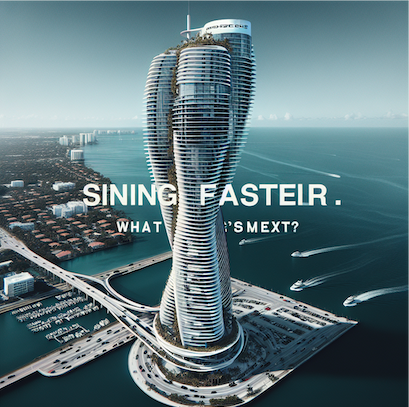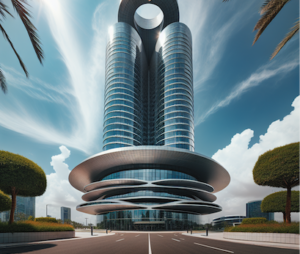The Porsche Design Tower in Miami, one of the city’s most iconic luxury residential buildings, has become the center of attention for reasons no one expected. Located in the upscale Sunny Isles Beach neighborhood, this towering 57-story skyscraper was designed to embody the cutting-edge of modern architecture, with its signature Porsche Design car elevator system and opulent amenities. But now, a concerning issue has surfaced—the Porsche Design Tower is sinking at a much faster rate than originally predicted.
First completed in 2017, the tower was a beacon of luxury, attracting ultra-wealthy residents and celebrities. Yet, recent reports indicate that the skyscraper is experiencing accelerated subsidence, sinking at a rate ten times faster than expected, raising alarms about its long-term stability and safety. What are the causes behind this unexpected phenomenon, and what are the potential consequences for the residents, developers, and the luxury real estate market in Miami? This article explores the Porsche Design Tower’s sinking problem, its causes, and the steps being taken to mitigate this pressing issue.
The Porsche Design Tower: A Symbol of Luxury and Innovation
Before the sinking issue became a topic of discussion, the Porsche Design Tower was a symbol of luxury, engineering excellence, and architectural innovation. Located on the pristine coastline of Sunny Isles Beach, Miami, the skyscraper stands at 649 feet tall and features 132 ultra-luxury residences. The building’s design, conceived by the architect Sieger Suarez and developed by Dezer Development, made waves for its world-first Porsche Design car elevator system.
One of the most unique features of the Porsche Design Tower was its “sky garage,” where residents could drive their vehicles directly into their apartments via an elevator system designed by Porsche, offering unparalleled convenience and privacy. These units are designed to reflect Porsche’s premium aesthetic, combining state-of-the-art technology with high-end amenities like private pools, expansive terraces, and sweeping ocean views. The cost for these luxurious units ranges from $6 million for a standard apartment to upwards of $30 million for the most exclusive penthouses.
For a time, the Porsche Design Tower embodied the cutting edge of luxury in Miami’s booming real estate market, attracting international investors and affluent individuals from around the globe. It was a beacon of Miami’s transformation into a cosmopolitan hub of luxury living. However, the recent reports of the building sinking have brought into question not only the structural integrity of this emblematic tower but also the sustainability of luxury coastal developments in the face of changing environmental conditions.
The Sinking Problem: An Unexpected Discovery
The Porsche Design Tower was initially designed with a foundation intended to handle the challenges posed by Miami’s unique geographical conditions. However, in recent months, engineers have detected an alarming and unexpected development: the building is sinking at a significantly faster rate than originally predicted. Recent geotechnical surveys have revealed that the tower is sinking about ten times faster than the initial predictions, raising serious concerns among both residents and developers.
Sinking, or “subsidence,” is a natural process in which the land beneath a structure settles over time. All buildings experience some level of subsidence, but the Porsche Design Tower’s rapid sinking is far beyond what engineers had anticipated. Originally, it was estimated that the building would sink gradually over several decades, but now, the rate of settlement is accelerating much faster than anyone expected.
Possible Causes Behind the Rapid Sinking
There are several factors that may contribute to the Porsche Design Tower’s accelerated sinking. Miami is built on relatively soft, sandy soil, which can shift over time, especially when subjected to the weight of a massive building like the Porsche Design Tower. This shifting of soil can lead to uneven settling, especially in areas near the coastline, which are more susceptible to changes in water levels and groundwater pressure.
The Porsche Design Tower’s foundation was designed to account for the city’s coastal conditions. Engineers used advanced techniques, including deep pilings, to anchor the structure to more stable layers of soil. However, the speed at which the building is sinking suggests that additional environmental factors may be contributing to the problem. These factors include rising sea levels, increased storm activity, and shifting groundwater levels.
Miami is particularly vulnerable to the effects of climate change. Rising sea levels, caused by global warming, have led to an increase in groundwater levels, which can undermine the stability of the soil beneath buildings. Furthermore, Miami experiences frequent and intense storms, which can erode the land and exacerbate soil instability. The combined impact of these environmental changes may have led to the accelerated subsidence of the Porsche Design Tower.
Soil Composition and Coastal Challenges
Miami’s soil consists primarily of sandy and silty layers, which are highly prone to settling and shifting over time. Coastal developments, like the Porsche Design Tower, face additional challenges due to the combination of water movement, changing tides, and the weight of the buildings themselves. In areas with soft soil, buildings are more likely to experience settling, which may lead to cracks in the foundation and uneven floors in the lower levels.
In addition, the Porsche Design Tower’s design, which includes a unique car elevator system and other engineering innovations, may have placed uneven pressure on the building’s foundation. This innovative design could be contributing to the faster-than-expected sinking, especially if the weight distribution was not fully accounted for during the initial planning stages.
Geotechnical and Structural Experts Weigh In
Leading engineers have provided their insights into the cause of the Porsche Design Tower’s subsidence. According to structural and geotechnical experts, soft soil conditions and rising groundwater levels are the most likely culprits behind the building’s accelerated sinking. Soil analysis indicates that the shifting of sand and clay beneath the foundation could be causing uneven subsidence across the structure. When a building sits on soft soil, the pressure from the structure can cause the ground to compress, leading to uneven settling.
Experts also point to the unique design of the Porsche Design Tower as a potential factor. The car elevator system, while groundbreaking in its technology, may have altered the way weight is distributed across the building’s foundation. Unlike traditional skyscrapers, which rely on conventional weight-bearing systems, the Porsche Design Tower’s reliance on its car elevator and other high-tech features may have contributed to uneven stress on the foundation.
The role of Miami’s rising sea levels cannot be ignored either. As the water table rises due to climate change, the soil beneath the tower becomes saturated, reducing its ability to support the structure’s weight. Combined with intense weather patterns, such as frequent storms and hurricanes, the rising sea levels could be accelerating the sinking process.
As a result, engineers are now looking at new ways to reinforce the building’s foundation, such as installing additional pilings or deepening the foundation to anchor the structure to more stable layers of soil. Some experts have even suggested that future coastal buildings in Miami may need to adopt more advanced techniques to deal with the unique challenges of the region’s shifting soil and rising water levels.
Impact on Residents and Property Value
The Porsche Design Tower’s sinking issue has already started to impact the lives of its residents. While no significant structural damage has been reported, subtle signs of subsidence are beginning to show. Some residents have noticed cracks in their walls, floors that are no longer level, and slight shifts in the alignment of doors and windows. While these issues are not yet catastrophic, they have raised concerns about the long-term stability of the building.
The impact on property values is also a significant concern. Miami’s luxury real estate market is highly competitive, with properties selling for millions of dollars. The Porsche Design Tower was once one of the city’s most desirable addresses, but the sinking problem could potentially reduce its appeal to prospective buyers. Even if the subsidence issue is eventually addressed, the building’s reputation may be damaged, making it harder for residents to sell their properties.
As the sinking issue becomes more widely known, it could trigger a broader shift in the luxury real estate market in Miami. Buyers may become more cautious about purchasing properties in coastal areas, especially if they begin to question the reliability of the region’s infrastructure. This could lead to decreased demand for high-end properties in Miami, particularly in areas like Sunny Isles Beach, where many luxury developments face similar environmental challenges.
The Developers’ Response
Dezer Development, the company responsible for the Porsche Design Tower, has responded to the situation by acknowledging the issue and committing to resolve it. The developers have expressed their concern for the safety and well-being of the tower’s residents and have promised to take swift action to address the accelerated sinking problem. A team of leading geotechnical engineers has been hired to conduct an in-depth investigation into the cause of the subsidence and to explore potential solutions.
One of the primary solutions being explored is the reinforcement of the building’s foundation. This could involve the installation of additional deep pilings to anchor the building more securely into the ground or the construction of a new foundation layer beneath the existing structure. The developers are also exploring the possibility of making improvements to the car elevator system and other parts of the building to distribute weight more evenly.
In addition to physical reinforcements, the developers have promised increased transparency with the residents. Many have expressed frustration with the lack of communication regarding the issue, and the developers have pledged to keep residents informed about the progress of the investigation and any necessary repairs. Regular updates, meetings, and open lines of communication will be prioritized to ensure that residents feel confident that the issue is being addressed appropriately.
The Future of Luxury Coastal Living
The Porsche Design Tower’s sinking issue has cast a shadow over Miami’s luxury real estate market, but it also serves as a reminder of the challenges faced by coastal developments in the face of climate change and environmental instability. While the issue has created significant concern, it also represents an opportunity for the industry to rethink how high-rise buildings are designed, constructed, and maintained in vulnerable coastal regions.
For now, residents of the Porsche Design Tower can only hope that the measures being taken will stabilize the building and ensure its longevity. However, the rapid sinking of this iconic structure serves as a wake-up call for both developers and buyers in Miami’s luxury real estate market. The future of coastal luxury living will likely require new approaches to building design and foundation technology, as well as a deeper understanding of the long-term impact of climate change on coastal cities.
As this situation unfolds, developers, residents, and city officials will be watching closely to see how the Porsche Design Tower responds to this crisis. The issue may prompt a reevaluation of how luxury properties are developed in Miami and other coastal cities, and the lessons learned could shape the future of high-rise construction in the years to come.
Feel free to check out our other website at :aibrainpowered.com














